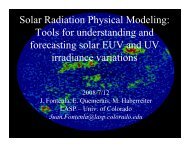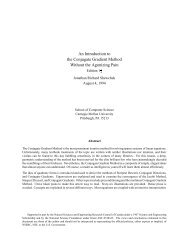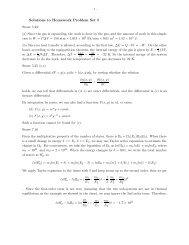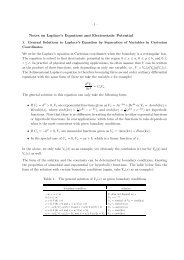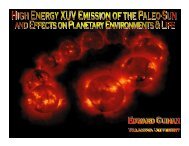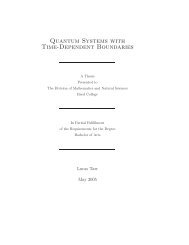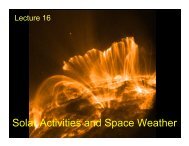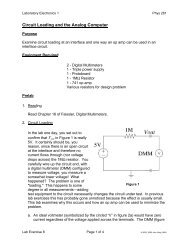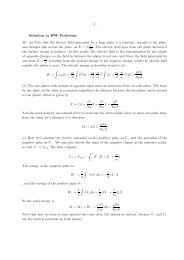312 Lab Manual - Solar Physics at MSU - Montana State University
312 Lab Manual - Solar Physics at MSU - Montana State University
312 Lab Manual - Solar Physics at MSU - Montana State University
Create successful ePaper yourself
Turn your PDF publications into a flip-book with our unique Google optimized e-Paper software.
1) Wh<strong>at</strong> color/region did you find to have the<br />
highest temper<strong>at</strong>ure? Did you measure infrared<br />
light? Did you record different values during different<br />
runs?<br />
2) Does it make sense to you wh<strong>at</strong> region had<br />
the peak temper<strong>at</strong>ure? In wh<strong>at</strong> color do you<br />
think the sun emits the most energy?<br />
3) Look <strong>at</strong> the following diagrams and corresponding<br />
discussions, then re-analyze your answer<br />
to question 2.<br />
4) Answer all questions posed in the discussion.<br />
List of visible wavelength ranges, for reference.<br />
Red<br />
620-700nm<br />
Orange 590-620<br />
Yellow 570-590<br />
Green 490-570<br />
Blue 440-490<br />
Violet 390-440<br />
There are 10 9 nanometers (nm) in a meter.<br />
Planck spectrum 5770K<br />
2´ 10 -7 4´ 10 -7 6´ 10 -7 8´ 10 -7 1<br />
Wavelength in meters<br />
You should recognize this plot as a Planck or<br />
blackbody spectrum. The radi<strong>at</strong>ed light from<br />
the sun can be approxim<strong>at</strong>ed by a blackbody<br />
<strong>at</strong> 5770K. Use Wien’s Law to find the peak<br />
wavelength of the Sun’s emission.<br />
Wien’s Law:<br />
Herschel Experiment<br />
To change a wavelength into a frequency, use<br />
the formula<br />
ln = 3*10 8 m/s<br />
where n is frequency in Hz and l is wavelength<br />
in meters.<br />
index of refraction<br />
1.55<br />
1.54<br />
1.53<br />
1.52<br />
1.51<br />
1.5<br />
1.49<br />
1.48<br />
1.47<br />
1.46<br />
Vari<strong>at</strong>ion of index of refraction for<br />
glass<br />
1.45<br />
200 300 400 500 600 700<br />
wavelength in nm<br />
The graph above is plot of how the index of<br />
refraction varies with wavelength in glass. There<br />
are actually many types of glass, and each has<br />
a somewh<strong>at</strong> different index of refraction. This<br />
one is for silica. If the plot were a straight line,<br />
“linear”, we would have equal spacing of wavelengths<br />
when light is refracted through a prism.<br />
However, the plot is not a line, but a curve which<br />
fl<strong>at</strong>tens out toward the red end of the spectrum.<br />
Due to the fact th<strong>at</strong> the index of refraction<br />
changes very little <strong>at</strong> the red end of the<br />
plot, the wavelengths there will be bunched up,<br />
more concentr<strong>at</strong>ed.<br />
l max<br />
= 2.9*10 6 /T<br />
Where l max<br />
is the peak wavelength of the<br />
Planck spectrum in nanometers and T is<br />
temper<strong>at</strong>ure in Kelvin.<br />
Is this the wavelength you expected? To obtain<br />
an energy from the Planck spectrum, integr<strong>at</strong>e<br />
over a wavelength range. If you are unfamiliar<br />
with the concept of integr<strong>at</strong>ion, you can think of<br />
it here as the area under the curve from one<br />
spot on the x axis to another. For example, you<br />
can see by simply looking <strong>at</strong> the plot th<strong>at</strong> the<br />
area under the curve between 200 and 300 nm<br />
is less than the area between 500 and 600 nm.<br />
Using this type of estim<strong>at</strong>ion, in which color does<br />
the sun emit the most energy? The difference<br />
between energy emitted from the sun in green<br />
and red is not gre<strong>at</strong>, but in a well done, corrected<br />
experiment, is measurable.<br />
You might now be asking yourself a logical question.<br />
If the sun emits the most in green, why<br />
does it appear yellow? In fact, it is an appearance.<br />
The sun is actually white, but against the<br />
blue sky, it looks yellow. Caution: never look<br />
directly <strong>at</strong> the sun - it can burn your eyes in a<br />
m<strong>at</strong>ter of only a fraction of a second. Astronauts<br />
in space observe the sun as white, due to the<br />
black r<strong>at</strong>her than blue background they see it<br />
against. To prove this to yourself, try the following<br />
experiment on your own time.<br />
21



